Physical Address
304 North Cardinal St.
Dorchester Center, MA 02124
Physical Address
304 North Cardinal St.
Dorchester Center, MA 02124
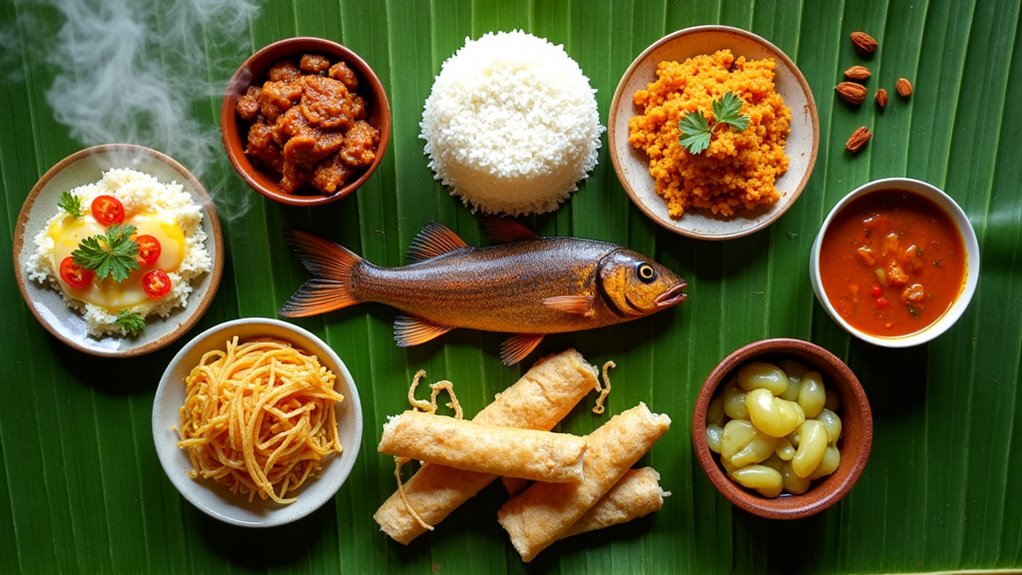
Glimpse into Sri Lanka's culinary paradise through 9 tantalizing dishes that blend ancient traditions with explosive flavors.
Sri Lankan cuisine offers a vibrant tapestry of flavors and cultural influences. You’ll find rice and curry as the national staple, alongside street-food sensation kottu with its distinctive chopping sounds. Don’t miss the crispy-edged hoppers, Dutch-inspired lamprais, or fiery pol sambol. From Jaffna crab curry to breakfast string hoppers, celebratory kiribath, and sweet-sour eggplant moju, each dish tells a story of Sri Lanka’s illustrious legacy. The journey through these nine wonderful dishes reveals centuries of culinary tradition.
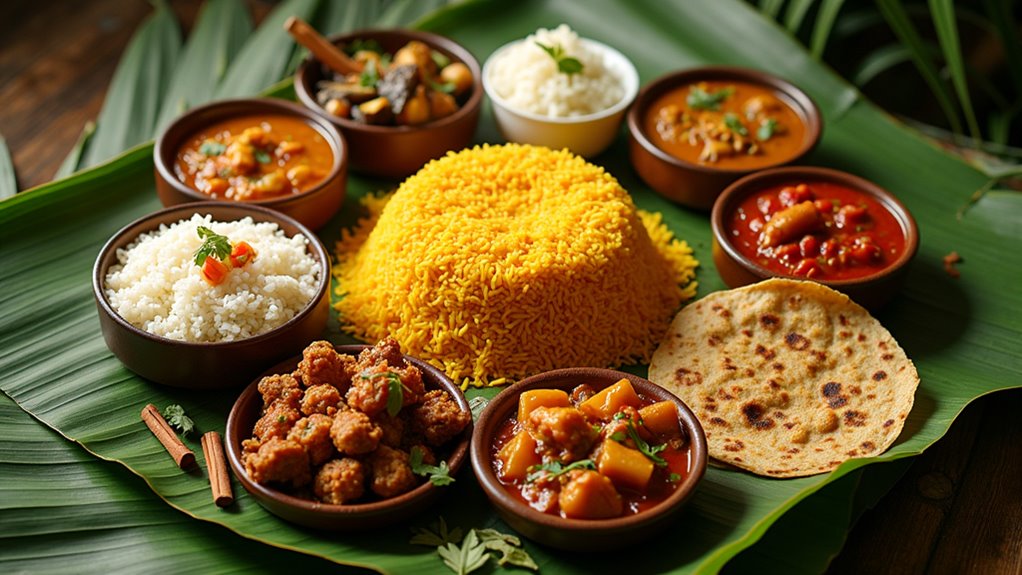
While many cuisines feature rice as a staple, Sri Lankan rice and curry stands as the undisputed national dish that embodies the island’s culinary identity. You’ll find this meal served primarily at lunch, though it appears at breakfast and dinner tables too.
The vibrant soul of Sri Lanka captured on a plate, transcending mealtime boundaries while honoring cultural heritage.
A typical serving includes boiled rice surrounded by three to four distinct curries—usually a combination of dal, vegetables like beetroot or eggplant, meat or fish, and condiments.
The foundation begins with aromatic spices like coriander, cumin, and cinnamon, often enhanced with creamy coconut milk.
When you visit a Sri Lankan home, rice and curry represents both hospitality and family tradition. Each household maintains unique preparations, reflecting regional variations and generations of culinary expertise.
The communal consumption of this dish symbolizes unity and cultural pride. Essential to authentic Sri Lankan flavors is the liberal use of curry leaves, which impart a distinctive aroma that cannot be replicated with other herbs.
This ingenious creation emerged in the 1960s from Sri Lanka’s eastern Tamil regions as a way to repurpose leftover godhamba roti. Chefs chop the flatbread on a hot griddle using two metal spatulas, creating the dish’s iconic rhythmic clatter that draws hungry customers.
The chopped roti is stir-fried with vegetables, eggs, meats, and aromatic spices, resulting in a flavorful, satisfying meal. You’ll find numerous variations including chicken, vegetable, egg, cheese, and seafood kottu. Many locals and travelers flock to notable establishments like Pilawoos in Colombo 3 and Hotel de Plaza for authentic kottu experiences.
More than just street food, kottu represents Sri Lanka’s cultural diversity, serving as a culinary bridge between the nation’s ethnic communities.
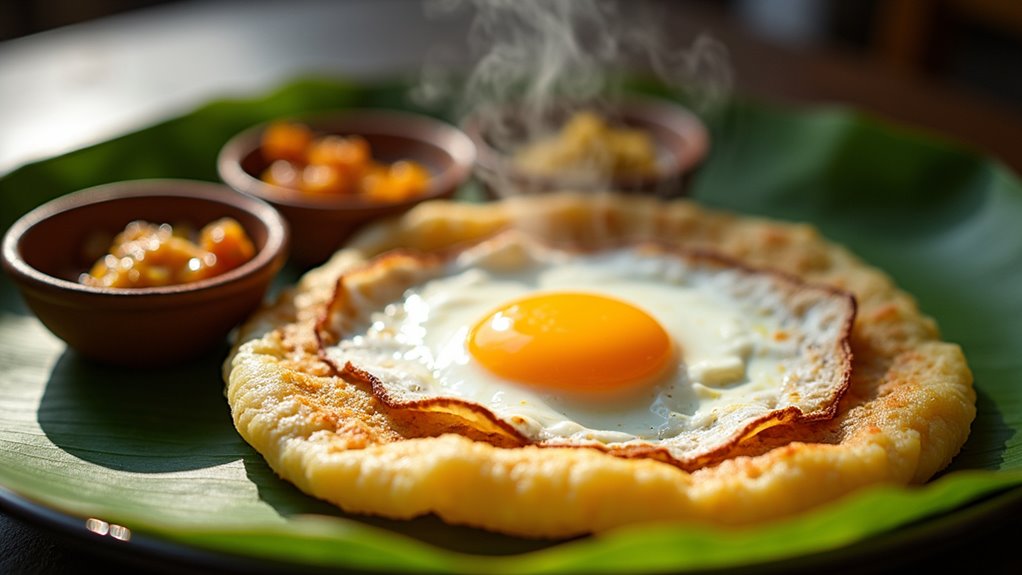
Beloved throughout Sri Lanka, hoppers (appam) represent one of the country’s most distinctive culinary creations. These crispy-edged, bowl-shaped pancakes are made from a fermented batter of rice flour, coconut milk, yeast, sugar, and salt.
You’ll find hoppers cooked in special appam pans where the batter is swirled to create their characteristic shape—crispy around the edges with a soft center. The batter requires patience, needing 18-20 hours of fermentation for authentic flavor. For egg hoppers, the cook adds whole eggs to the center while the batter cooks, creating a delicious protein-rich variation.
Whether you enjoy them plain or with an egg cracked into the center, hoppers are a versatile breakfast staple. They’re traditionally served with spicy accompaniments, reflecting Sri Lanka’s bold flavor profile.
Though simple in appearance, hoppers showcase the importance of fermentation techniques in Sri Lankan cuisine.
Representing one of Sri Lanka’s most fascinating culinary fusions, lamprais showcases the opulent cultural exchange between Dutch colonists and local traditions. This banana leaf-wrapped parcel (from Dutch “lomprijst” meaning “food packet”) combines rice cooked in aromatic meat stock with various curries and sides.
You’ll find the rice infused with cardamom, cinnamon, and cloves, accompanied by meat curry, eggplant, and traditional Dutch-style meatballs called frikkadels. The banana leaf wrapping isn’t just for presentation—it adds distinctive flavor while keeping everything moist.
Preparation is elaborate, beginning the night before with slow-cooked meats. The completed parcels are baked to meld the flavors. Though primarily associated with the Dutch Burgher community, lamprais embodies Sri Lanka’s multicultural heritage and remains a celebratory dish passed down through generations. The authentic preparation process is labor-intensive and time-consuming, sometimes taking up to a week to complete all components properly.
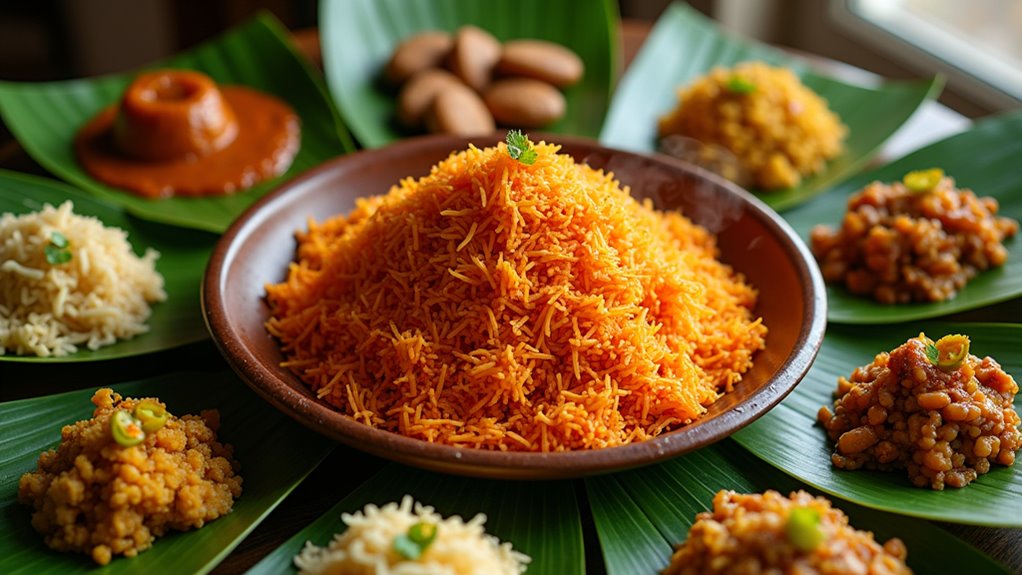
Bursting with fiery heat and creamy coconut texture, pol sambol stands as one of Sri Lanka’s most essential condiments. You’ll find this versatile relish accompanying everything from hoppers and dosas to rice dishes and chapatis.
Traditional preparation involves grinding freshly grated coconut with red chilies, shallots, lime juice, and salt using a mortar and pestle. While modern cooks might opt for a food processor, the classic method releases more flavor through careful pounding.
The beauty of pol sambol lies in its customizable heat level—adjust the chilies to suit your preference. Many Sri Lankans enhance the flavor profile by incorporating Maldive fish flakes for an added umami dimension.
This beloved condiment carries deep cultural significance, often featured at family gatherings and festivals. Its perfect balance of spicy, tangy, and sumptuous flavors represents the essence of Sri Lankan cuisine that has been cherished across generations.
From the northern coastal region of Sri Lanka, Jaffna Crab Curry emerges as one of the country’s most celebrated seafood specialties. This traditional Tamil dish features whole crabs simmered in a sumptuous gravy of coconut milk, roasted curry powder, and curry leaves. The century-old recipe originates from Karaveddy village and embodies authentic Sri Lankan culinary heritage.
What sets Jaffna crab curry apart is its distinctive spice blend called eraichithool, containing fennel, cardamom, and nutmeg. Unlike other Sri Lankan curries that use tamarind, this recipe often incorporates fresh lime juice for brightness.
You’ll find the crabs are cleaned with top shells removed for easier eating, then gently cooked until pink and infused with flavor. Typically served during special occasions with rice or roast bread, this curry represents generations of culinary expertise passed down through Jaffna’s coastal communities.
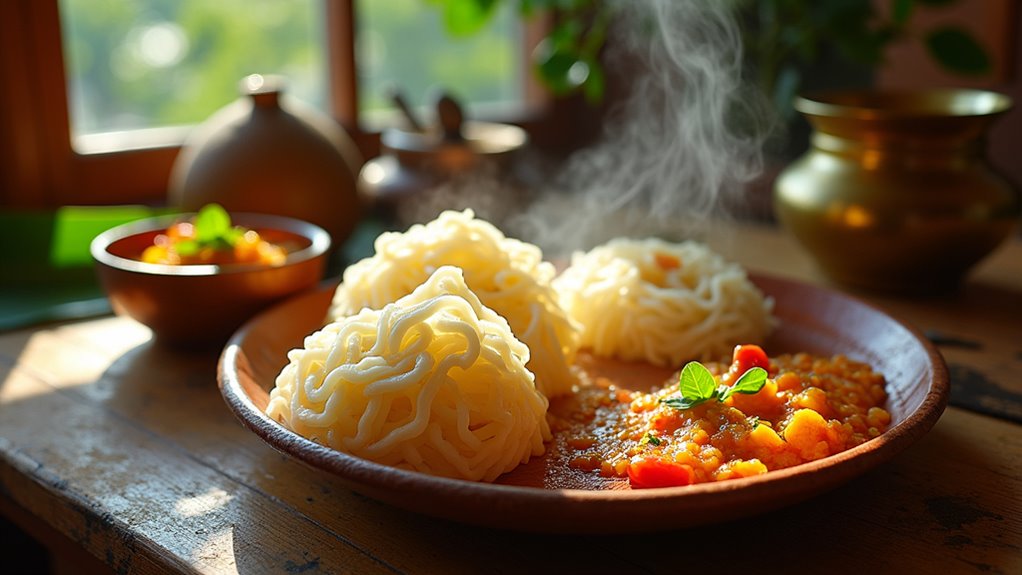
At the heart of Sri Lankan breakfast culture, string hoppers with dhal curry stands as perhaps the most beloved morning meal across the island. These delicate rice noodles are steamed to perfection after being pressed into thin strands from a simple rice flour and water dough.
You’ll find them served alongside creamy dhal curry made from red lentils simmered with coconut milk, curry leaves, and aromatic spices. The combination provides a balanced meal of carbohydrates and protein, making it both nutritious and satisfying.
This pairing reflects centuries of culinary tradition and cultural exchange with neighboring South India. The preparation involves skilled techniques like precise steaming for the hoppers and careful tempering of spices for the dhal, creating a harmonious breakfast experience that’s authentically Sri Lankan. What makes this dish even more convenient is that the dhal curry can be prepared in approximately 15 minutes, making it perfect for busy mornings.
Kiribath, Sri Lanka’s celebrated milk rice, holds a revered place in both everyday meals and special occasions throughout the island nation. This national dish symbolizes prosperity and abundance, traditionally prepared by cooking rice with water and then adding coconut milk for a creamy, opulent texture.
When you encounter kiribath in Sri Lanka, you’ll notice:
You’ll find kiribath served as a breakfast staple and during important family gatherings, offering a perfect balance of simplicity and cultural significance. In many Sri Lankan households, kiribath often replaces cake at birthday celebrations, continuing a meaningful tradition passed through generations.
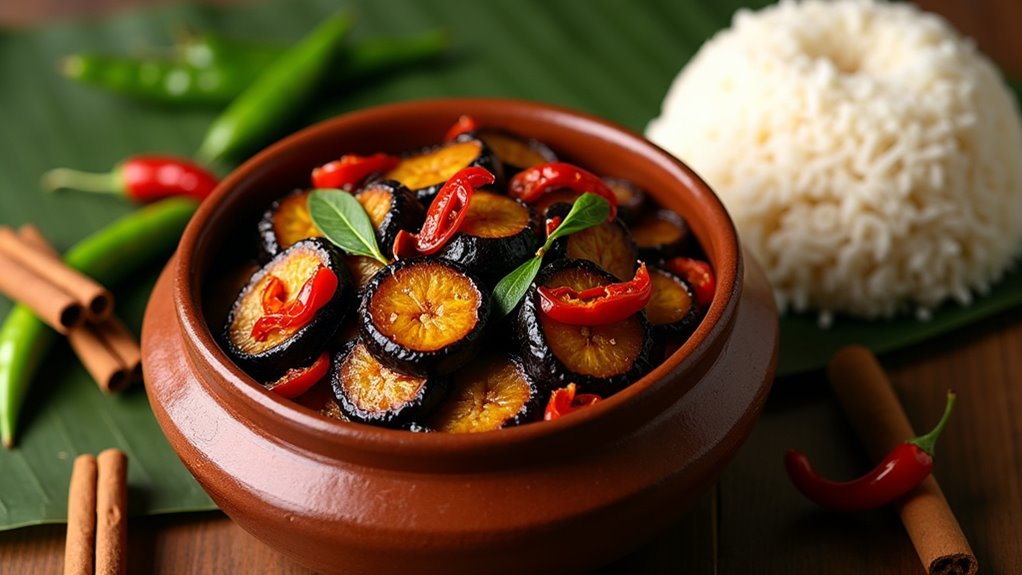
Among Sri Lanka’s most beloved side dishes, Eggplant Moju is prominent for its perfect balance of sweet and sour flavors. You’ll find this dish at festive occasions and family gatherings, where it’s served as a flavorful accompaniment to rice and curry.
To prepare authentic Eggplant Moju, deep-fry 500g of thick-cut eggplant strips until crispy, then do the same with shallots. The key to achieving the perfect texture is cutting eggplants into very thin slices that crisp quickly and retain less moisture.
The dish gets its distinctive taste from a blend of turmeric, ginger-garlic paste, mustard powder, and green chilies. Vinegar provides the essential sour element, while sugar balances with sweetness.
Beyond its delicious taste, Eggplant Moju offers nutritional benefits—it’s low in calories, high in fiber, and packed with antioxidants.
The vinegar also gives it an impressively long shelf life, making it perfect for making ahead.
Sri Lankan cuisine will transport your taste buds to paradise with its complex flavors and diverse influences. You’ll find comfort in rice and curry, excitement in kottu roti, and pure joy in the perfect hopper. Whether you’re sampling fiery pol sambol or indulging in a fragrant lamprais, Sri Lanka’s food culture offers an endless culinary adventure that’ll have you dreaming of these dishes for a million years to come.